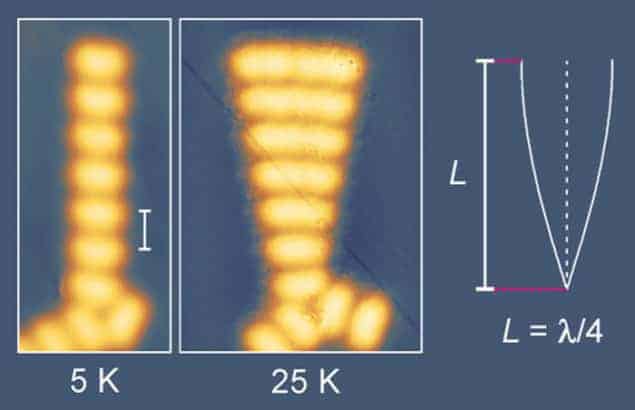
Researchers in Austria have made the smallest ever man-made nanomechanical resonator from just four molecules. The oscillating cantilever is not only of interest for fundamental studies in quantum physics, but could also be used to detect single atoms or molecules.
Nanomechanical resonators are tiny vibrating beams that oscillate at very high resonant frequencies – often in the megahertz or gigahertz range. As a result, they can find use in a range of applications including telecommunications and even quantum computing. They can also be used to detect and determine the mass of tiny objects, such as single DNA molecules or viruses. When a small particle is absorbed onto the beam, it alters the frequency at which the beam vibrates and this change can be monitored and used to calculate the mass of the particle.
Tiny resonators
A team led by Stefan Müllegger at the Johannes Kepler University in Linz has now made the tiniest such resonator ever from just four molecules of α,γ-bisdiphenylene-β-phenylallyl (or BDPA). In previous work, the researchers showed that when BDPA molecules are deposited on the (111) crystallographic surface of gold, they segregate into triangular clusters. Some of these clusters then act as nucleation sites and allow a chain of molecules to grow in one direction and form tiny resonating structures. The molecules in these chains are separated by about 0.7 nm.
Now, the same team has succeeded in imaging these molecules by moving a scanning tunnelling microscope (STM) tip across the chain and measuring the small electrical current between the tip and the gold surface. The researchers found that at a temperature of 5 K, the chain appears as a thin line of molecules. However, when the temperature is increased to 20 K or higher, the molecules in the chain look wider the further the tip is moved along the chain from the end that is fixed to the gold surface (see figure). These observations indicate that the chain is vibrating, say Müllegger and colleagues.
Unexpected behaviour
The team points out that the vibration is unexpected because of the nature of the bonds between the molecules, which are relatively weak. In theory, the chains should not resonate as observed because such vibrations were only thought to occur in nanostructures such as graphene and carbon nanotubes, which are held together by stronger chemical bonds.
The team has also come up with a way to measure the frequency of the structure by modifying its STM so that it can detect tunnelling currents in the radio-frequency range. The researchers found that a five-molecule chain resonates at 98 MHz and, just like the strings in musical instruments, these frequencies decrease as the chain length increases. For example, a four-molecule chain was found to resonate at around 127 MHz while a seven-molecule chain resonated at about 51 MHz.
“Our study shows that radio-frequency scanning tunnelling microscopy is a complementary new experimental tool for characterizing dynamic processes at the scale of single molecules in nanoscience and technology,” says Müllegger. “We now hope to study the mechanisms behind a molecular chain’s vibrations and further adapt our modified STM for single-molecule magnetic resonance spectroscopy,” he says.
The research is described in Physical Review Letters.
- This article first appeared on nanotechweb.org



